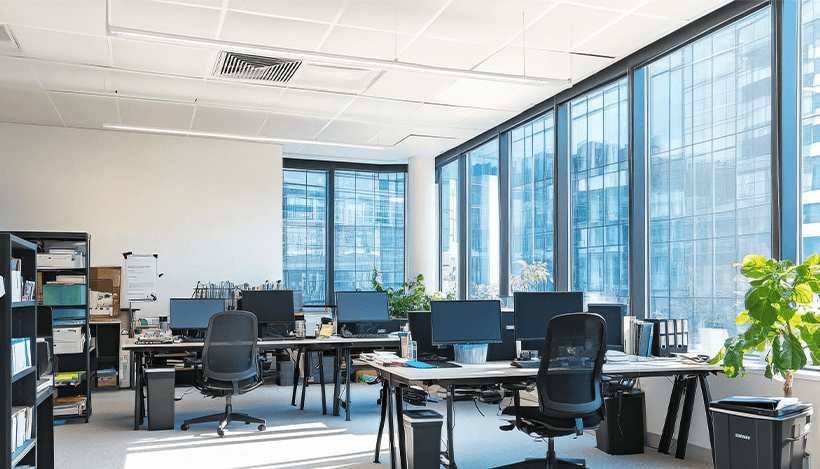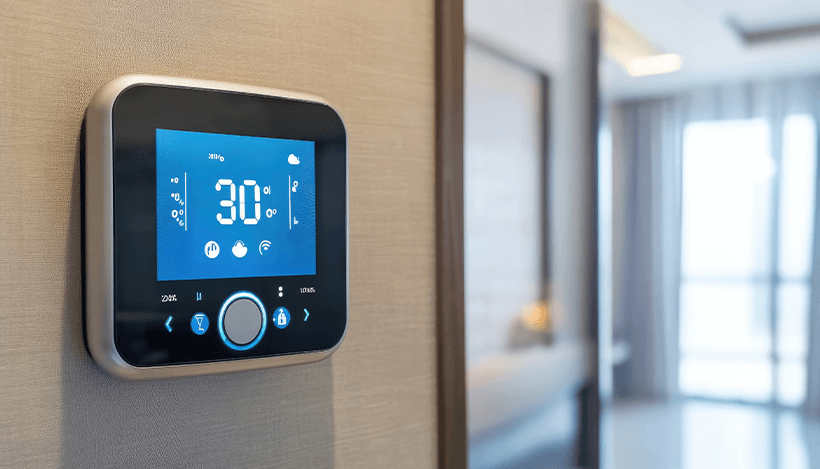We introduce Nitto's electrochromic technology and control device technology, which are our technical assets, as technologies for realizing dimmable glass that reduces the power consumption of air conditioning and lighting. Would you like to use Nitto's Electrochromic technology to create more environmentally friendly, energy-saving spaces and differentiate from other companies?
Energy saving in the office is extremely important for both cost reduction and environmental protection for companies. In recent years, many companies have been strengthening their energy-saving measures due to rising energy costs and growing environmental awareness. In the office environment, in particular, lighting and air conditioning account for a large percentage of energy consumption, and there is a growing need to improve the efficiency of these systems. In fact, data has also been reported that air conditioning accounts for about 48.6% of the power consumed by office buildings, and lighting accounts for about 23.1%*1.
One example of energy-saving measures for lighting and air conditioning is the introduction of dimmable glass technology. By taking full advantage of natural light and adjusting the transparency of the glass as necessary, it is possible to optimize the use of lighting and air conditioning, resulting in significant energy savings.
 (January 23, 2025)
(January 23, 2025) |
Applying an electric current causes a redox reaction that changes the color and transparency of the glass. This reaction is reversible and can be restored to its original state by reversing the electric current. The Electrochromic technology makes it possible to maintain transparency.
Applying a voltage changes the orientation of the liquid crystal molecules and adjusts the transparency of the glass. Turning off the voltage causes the liquid crystal molecules to be aligned randomly, scattering the light and making the glass opaque. PDLC technology allows instantaneous adjustment of transparency.
The color of the glass changes in response to temperature changes. As the temperature rises, the glass darkens and blocks out the sunlight. On the other hand, as the temperature falls, the glass becomes transparent and allows sunlight in. This method automatically adjusts sunlight and reduces the load on air conditioning, contributing to improved energy efficiency.
Microscopic particles are floating in the liquid. Applying a voltage causes the particles to be aligned and allows light to pass through. Turning off the voltage causes the particles to be aligned randomly, blocking the light. This method allows instantaneous switching and fine adjustment of the light transmission rate.
| Features/Technology | Electrochromic method | PDLC method | Thermo chromic method | SPD method |
|---|---|---|---|---|
| Structure | Color and transparency change by redox reaction when electric current is applied | Liquid crystal aligns by voltage, and transparency changes | Color changes in response to temperature changes | Microscopic particles are aligned by voltage, and control light transmission |
| Energy efficiency | High | High | Medium level | High |
| Response speed | Seconds to minutes | High speed (in milliseconds) | Dependent on natural temperature changes | High speed (in milliseconds) |
| Examples of use | Architecture, Automotive, Display | Architecture, Automotive, Display | Construction, Automotive | Construction, Automotive, Aircraft |
Electrochromic technology has many advantages among the technologies to realize dimmable glass.
Energy is consumed only when an electric current is applied. Therefore, no energy is required to maintain color or transparency over long periods of time.
The transparency of the windows can be adjusted according to the amount of current, allowing the amount of sunlight to be controlled and the temperature of the room to be regulated. This reduces the use of air conditioning and cut downs on energy consumption.
Reducing energy consumption results in a reduction CO2 emissions. Especially, its introduction in large office buildings and commercial facilities is expected to significantly reduce environmental impact.
 |
Nitto owns not only electrochromic technology, but also intellectual property related to control systems so that this technology can be used to its full potential. We believe that our intellectual property can contribute to maximizing energy savings and creating a comfortable room environment. In particular, we have the following strengths.
Smart window controllers automatically adjust window transmittance based on predictive data from the external environment to reduce heating and cooling loads. Dimming elements also effectively control solar radiation and reduce energy consumption.
The design of the dimming element allows it to be applied to curved surfaces, making it suitable for a variety of shapes and applications. This is expected to lead to a wide variety of applications in fields as diverse as architecture, automotive, and mobility.
Smart window controllers maintain optimal room temperature, and dimming elements adjust room brightness to create a comfortable living space.
Improving energy efficiency also contributes to environmental protection. Nitto's technology plays an important role in aiming for a sustainable future.
 |
Nitto's unique technical assets related to electrochromic technology can add value to your products and contribute to revenue growth. Since Nitto is also actively working to provide these released technologies, please contact us if you would like to consider utilizing this IP.
Electrochromic technology is an advanced technology that contributes greatly to improving energy efficiency and reducing environmental impact. We believe that the combination of Nitto's electrochromic technology and control systems can make a greater contribution to the environment and is expected to find applications in a variety of fields. Please contact us if you are interested in intellectual property related to electrochromic technology.
| Patent No | LINK | Others |
|---|---|---|
| JP6893262B2 | LINK of patent information | ― |
| JP7274458B2 | LINK of patent information | ― |
The information on this page is based on the information as of April, 2025, and the patent rights status may differ from the latest status.
The following is an example of the flow for utilizing Nitto's patents.


Nitto is looking for partners and companies who want to use our patents to create a better future together.
If your company is interested in using Nitto's patents, please contact us through the inquiry form.
Intellectual Property Department 3, Technology and IP Strategy Division